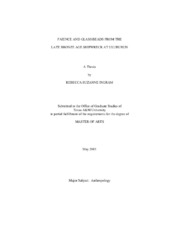| dc.description.abstract | Beads are one of the earliest forms of ornamentation created by humans; prized
during the Bronze Age for both their aesthetic as well as amuletic value, beads also
served to signify the social status of the wearer. Beads functioned as an important trade
commodity during the Late Bronze Age, as demonstrated by their abundance aboard the
Uluburun shipwreck. This Late Bronze Age shipwreck, discovered off the Turkish coast
at Uluburun in 1982, dates to approximately 1300 B.C. Thousands of beads of vitreous
material were found on the shipwreck, including approximately 75,000 faience beads
and 9,500 glass beads.
Bead form and style represented in the faience and glass beads at Uluburun are
relatively simple and are quite common at archaeological sites throughout the Late
Bronze Age Levant. Faience beads found at Uluburun vary widely in form and comprise
eight distinct categories. While the surface glaze remains in rare patches only, most
faience beads exhibit a blue undertone. Other colors, while less common, include red,
yellow, white and turquoise. The glass beads found at Uluburun may be loosely grouped
into two categories, small and large. Many of the large glass beads exhibit yellow and
white spot or crumb decoration, or a combination of both, and there is a distinctpossibility that all the large glass beads were decorated in this way, but surface
deterioration masks the decoration.
Many of the faience and glass bead categories represent items of cargo, as
evidenced by a concreted lump of small glass beads transported inside a Canaanite jar.
Other, less prolific, bead categories probably represent the personal belongings of the
crew or passengers aboard the ship.
Beads found in archaeological contexts are notoriously difficult to date due to
their extended use throughout generations; for this reason, the Uluburun beads represent
an important contribution to the archaeological record and bead studies in particular, for
the mere fact that they may be dated by provenance alone to the late 14th century B.C. | en |


